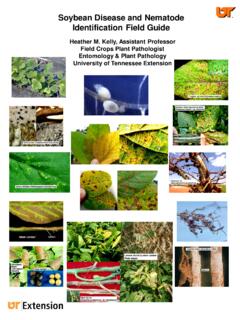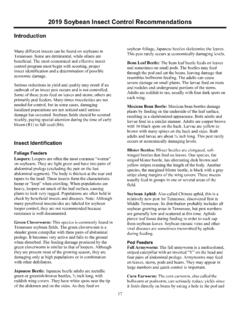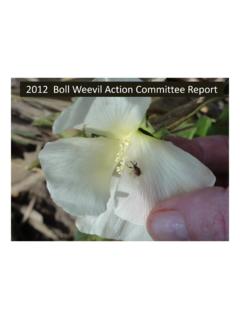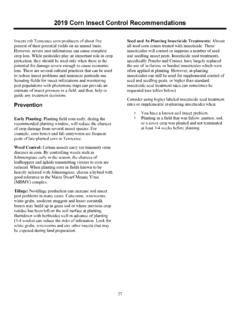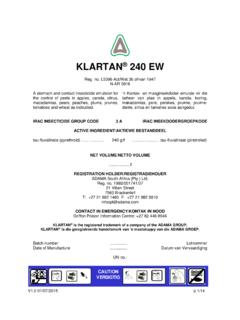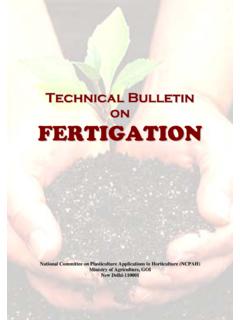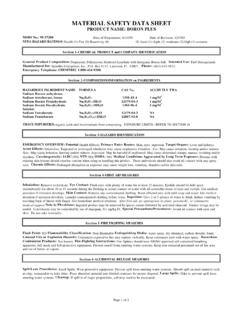Transcription of Cotton Production in Tennessee - UTcrops.com
1 Cotton Production in Tennessee Christopher L. Main, Associate Professor Extension Cotton and Small Grains Specialist, Plant SciencesW288 Cotton Production ranks third in terms of cash receipts from crops for Tennessee producers.
2 Tennessee annually produces about 550,000-650,000 acres of Cotton . Average lint yields range from 600 to 900 pounds of lint per acre. Cotton is produced in 23 counties statewide, with the majority grown in the western part of the state. Limited acres are grown under irrigation. Tennessee has long been a proponent of conservation and no-tillage systems, with approximately 52 percent of the Cotton grown no-till and an additional 24 percent grown using some form of conservation tillage. Field Selection and PreparationCotton is best adapted to soils that are fertile, moderately deep to deep with good drainage, and high moisture-supplying capacity.
3 Well-drained soils will tend to warm up early in the spring, allowing for early planting. Selecting fields with long rows, easy access and few obstacles allows for efficient use of equipment. In no-tillage Production systems, erosion problems should be addressed by implementing practices such as waterways, contour planting and filter strips along drainage ditches. Sub-soiling is only beneficial if tillage pans exist and/or heavy traffic has occurred. However, three or four years of continuous no-till Production has been found to reduce or eliminate traffic pans. Good Cotton stands may be obtained by no-tillage or conventional methods of seedbed preparation.
4 A firm, well-prepared seedbed is important for fast seedling emergence and uniform stands. On soils with erosion problems, no-tillage Production practices should be utilized. In conventional tillage areas, delay tillage until late winter or early spring to reduce the erosion potential. However, prepare seedbeds early enough so they will settle and firm up before planting. To prepare a seedbed on heavy-textured Delta soils, bed the land in the fall or winter. Use appropriate herbicides to kill weeds prior to planting Cotton to promote a vigorous early residues from Cotton , corn, soybeans or grain sorghum may provide sufficient cover on some fields for erosion control.
5 Where crop residues are not adequate, cover crops may be needed. Cover crops that have been used in Tennessee include small grain (wheat and rye) and legumes (vetch, crimson clover or Austrian winter peas). Small grains, especially wheat, are usually preferred for no-till Cotton . Small grains have a fibrous root system and will do a better job of binding the soil particles together than clovers, thereby reducing soil erosion. Rye tends to grow tall and produce more ground cover potentially shading out early season weeds. Excessive growth can interfere with planting, cause slow Cotton emergence, and could also produce tall, thin Cotton plants.
6 Legumes can be more difficult to manage. They are usually more difficult to kill and the nitrogen produced may cause the Cotton to be difficult to manage in late season. Do not plant Cotton until cover crops and weeds are killed to prevent a green bridge for early-season insects to move from the weeds to seedling FertilityCotton is very sensitive to soil fertility and Production practices. It is important to supply all the nutrients that may be needed in each field. Many problems can be related either directly or indirectly to acid soils and low levels of plant nutrients. Fertilization and liming programs should be based on the fertility of the soil.
7 A soil test is the first step in a sound fertility program. Samples should be collected during fall or early winter and sent to a soil testing laboratory for analysis and recommendations (Table 1).Figure 1. Nutrient availability at varying soil pH levels. medium slightly very very slightly medium strongly acid acid acid slightly slightly alkaline alkaline strongly alkaline acid alkaline nitrogen phosphorus potassium sulphur calcium magnesiumiron manganese boron copper and zinc molybdenum LimeYields will be highest and fertilizers used most efficiently when the
8 Soil pH is to (Figure 1). Calcium supplied by ground limestone aids in setting fruit and proper maturing of bolls. Soil acidity will also influence the availability of some plant nutrients, herbicide activity, seedling development and seedling high rates of acid-forming fertilizers will gradually lower the soil pH. A 100-pound per acre application of nitrogen in the form of anhydrous ammonia, ammonium nitrate or urea would require approximately 400 pounds of limestone to neutralize the acidity resulting from the nitrogen application. NitrogenGeneral nitrogen recommendations are based on research by University of Tennessee AgResearch and UT Extension.
9 The amount of nitrogen needed depends on the soil and its previous cropping history. Generally, 60 to 80 pounds of nitrogen are needed on upland soils where excessive growth and late maturity are not a problem. On bottom soils or sites where excessive growth is a problem, 45 to 60 pounds of nitrogen should be various nitrogen sources are similar in supplying nitrogen for plant growth. Nitrogen can be applied at or just prior to planting or may be split with sidedressing applications no later than early square stage. Nitrogen deficiency symptoms first appear on the lower leaves. The leaves of nitrogen-deficient plants become light green to pale yellow.
10 As they age, shades of red develop and then they turn to brown. Leaves then dry out and shed from the plant. The entire plant will be stunted and weak in appearance and fruit set will be nitrogen-deficient conditions, nitrogen can be applied to the soil as a side-dress application until about the third week of bloom. Foliar-applied fertilizer, while costly, can supply in-season nutrients for Cotton plants. However, foliar fertilizer should not be the primary source of nutrient supply for the crop. Mid-season applications of nitrogen may increase the risk of excessive late-season growth and delayed (P205 )The amount of phosphorous in a Cotton plant is low compared to levels of nitrogen and potassium.
